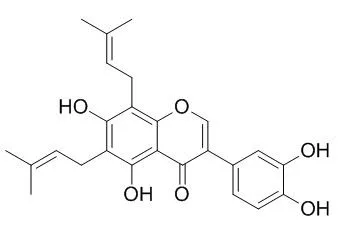| Description: |
6,8-Diprenylorobol possesses weaker anti-H. pylori activity, it may be a useful chemopreventive agent for peptic ulcer or gastric cancer in H. pylori-infected individuals; it is evaluated against the AIDS-related opportunistic fungal pathogens, Candida albicans and Cryptococcus neoformans. 6,8-Diprenylorobol shows anti-estrogenic activity comparable to that of 4-hydroxytamoxifen, a typical estrogen receptor (ER) antagonist. 6,8-Diprenylorobol shows promising cytotoxic effects toward HL-60 cells (IC50 4.3 ± 0.7 to 18.0 ± 1.7 uM), it also may be a possible candidate for the treatment of neurodegenerative diseases. 6,8-Diprenylorobol has antioxidant activity, it can reduce A2E photooxidation in a dose dependent manner. |
| In vitro: |
| Life Sci. 2002 Aug 9;71(12):1449-63. | | Anti-Helicobacter pylori flavonoids from licorice extract.[Pubmed: 12127165] | Licorice is the most used crude drug in Kampo medicines (traditional Chinese medicines modified in Japan). The extract of the medicinal plant is also used as the basis of anti-ulcer medicines for treatment of peptic ulcer.
METHODS AND RESULTS:
Among the chemical constituents of the plant, glabridin and glabrene (components of Glycyrrhiza glabra), licochalcone A (G. inflata), licoricidin and licoisoflavone B (G. uralensis) exhibited inhibitory activity against the growth of Helicobacter pylori in vitro. These flavonoids also showed anti-H. pylori activity against a clarithromycin (CLAR) and amoxicillin (AMOX)-resistant strain. We also investigated the methanol extract of G. uralensis. From the extract, three new isoflavonoids (3-arylcoumarin, pterocarpan, and isoflavan) with a pyran ring, gancaonols A[bond]C, were isolated together with 15 known flavonoids. Among these compounds, vestitol, licoricone, 1-methoxyphaseollidin and gancaonol C exhibited anti-H. pylori activity against the CLAR and AMOX-resistant strain as well as four CLAR (AMOX)-sensitive strains. Glycyrin, formononetin, isolicoflavonol, glyasperin D, 6,8-Diprenylorobol, gancaonin I, dihydrolicoisoflavone A, and gancaonol B possessed weaker anti-H. pylori activity.
CONCLUSIONS:
These compounds may be useful chemopreventive agents for peptic ulcer or gastric cancer in H. pylori-infected individuals. | | J. Funct. Foods, 2017, 29:104-14. | | Orobol derivatives and extracts from Cudrania tricuspidata fruits protect against 6-hydroxydomamine-induced neuronal cell death by enhancing proteasome activity and the ubiquitin/proteasome-dependent degradation of α-synuclein and synphilin-1[Reference: WebLink] | We investigated the neuroprotective effects of orobol derivatives and ethanol extracts from Cudrania tricuspidata fruits.
METHODS AND RESULTS:
Among the nine isolates from a 50% ethanol extract from Cudrania tricuspidata fruits (CTE50), orobol (OB), 6-prenylorobol (POB), and 6,8-Diprenylorobol (DPOB) showed neuroprotective effects in 6-OHDA-induced SH-SY5Y cell death. In addition, CTE50 and the three orobol derivatives (OB, POB, and DPOB) attenuated the cleavage of caspase-3, caspase-9, and PARP and inhibited the excessive generation of ROS. Furthermore, it enhanced the 6-OHDA-induced dysfunction of proteasome activity and reduced the accumulation of ubiquitin conjugated-proteins and the polyubiquitination of α-synuclein and synphilin-1. The proteasome inhibitor MG132 blocked the neuroprotective effects and the enhanced proteasome activity produced by CTE50 and the three orobol derivatives.
CONCLUSIONS:
These results demonstrate that CTE50 and three orobol derivatives protect against 6-OHDA-induced neurotoxicity by enhancing the ubiquitin/proteasome-dependent degradation of α-synuclein and synphilin-1, suggesting that they might be possible candidates for the treatment of neurodegenerative diseases. | | J Asian Nat Prod Res. 2017 May;19(5):510-518. | | Prenylated isoflavones from Cudrania tricuspidata inhibit NO production in RAW 264.7 macrophages and suppress HL-60 cells proliferation.[Pubmed: 27649772] |
METHODS AND RESULTS:
Inhibitory effects of NO production in RAW 264.7 macrophages guided the isolation of nine prenylated isoflavones, including a new cudraisoflavone L (1) and eight known metabolites furowanin B (2), erysubin A (3), wighteone (4), lupalbigenin (5), laburnetin (6), isolupalbigenin (7), 6,8-Diprenylorobol (8), millewanin H (9) from the leaves of Cudrania tricuspidata.
CONCLUSIONS:
At the concentration of 10 μM, compounds 1, 2, and 4 significantly inhibited NO production with the inhibitory values of 72.5 ± 2.4, 66.9 ± 1.8, and 55.4 ± 2.7%, respectively. In addition, all of isolated compounds 1-9 showed promising cytotoxic effects toward HL-60 cells (IC50 4.3 ± 0.7 to 18.0 ± 1.7 μM). | | Nat. Prod. Sci., 2011(17):206-11. | | Isolation of Prenylated Isoflavonoids from Cudrania tricuspidata Fruits that Inhibit A2E Photooxidation.[Reference: WebLink] |
METHODS AND RESULTS:
High-performance liquid chromatography coupled to an online -based assay (online HPLC-) system was used to determine the principal antioxidants in Cudrania tricuspidata fruits. Six prenylated isoflavonoids (1 - 6) were isolated from C. tricuspidata fruits according to the online HPLC- system. The structures of isolated compounds, alpiniumisoflavone (1), 6,8-Diprenylorobol (2), 6,8-diprenylgenistein (3), pomiferin (4), 4'-methylalpiniumisoflavone (5), and osajin (6) were identified by their retention time, UV spectra, ESI-MS, and NMR data.
CONCLUSIONS:
Among these compounds, 6,8-Diprenylorobol (2) and pomiferin (4) reduced A2E photooxidation in a dose dependent manner. |
|






 Cell. 2018 Jan 11;172(1-2):249-261.e12. doi: 10.1016/j.cell.2017.12.019.IF=36.216(2019)
Cell. 2018 Jan 11;172(1-2):249-261.e12. doi: 10.1016/j.cell.2017.12.019.IF=36.216(2019) Cell Metab. 2020 Mar 3;31(3):534-548.e5. doi: 10.1016/j.cmet.2020.01.002.IF=22.415(2019)
Cell Metab. 2020 Mar 3;31(3):534-548.e5. doi: 10.1016/j.cmet.2020.01.002.IF=22.415(2019) Mol Cell. 2017 Nov 16;68(4):673-685.e6. doi: 10.1016/j.molcel.2017.10.022.IF=14.548(2019)
Mol Cell. 2017 Nov 16;68(4):673-685.e6. doi: 10.1016/j.molcel.2017.10.022.IF=14.548(2019)